Copperheads (Agkistrodon contortrix) are the most common venomous snake that you’ll find in South Carolina. A species of pit viper more likely to strike than not, so it’s important to prepare. This is especially true if you plan on spending any time in the areas of South Carolina where copperheads live.
The number one way to prepare to keep yourself safe is to learn how to recognize and avoid them. This copperhead in South Carolina guide will walk you through everything from identifying the copperhead among similar snakes, learning where they live, and learning how and when they bite.
Ready to learn more? Keep reading!
What Does a Copperhead Look Like?
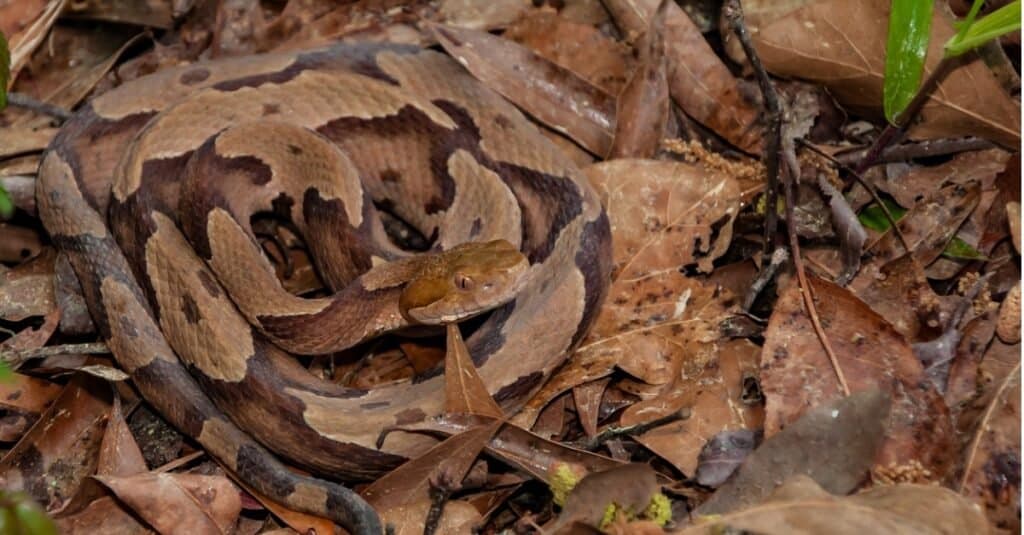
Copperheads are easily hidden on the ground because of their color.
©iStock.com/JasonOndreicka
Copperheads are just one of many brown snakes found in both South Carolina and the United States as a whole. However, while they may have several look-alikes – which we’ll discuss further below – there are a few key markings that can help you identify a potential copperhead.
First, copperheads are relatively long, heavy snakes. Adults can reach lengths up to 3 feet – the same length as a baseball bat. While there are many other snakes with light reddish-brown scales, you can easily identify them by the unique hourglass-shaped patterns on their back. They also sport the typical venomous snakehead, which is large and wide to support their venom glands.
Baby copperheads, known as snakelets, also can pack a venomous bite. However, they can look different than their adult counterparts. When copperheads are young, their tails have a distinct green coloration that will fade to dark brown as they mature. However, they’ll still have a developing hourglass pattern and ruddy brown coloring, just like adults.
Where Do Copperheads Live?
Copperheads can be found all across the eastern United States, including in South Carolina.
Here, they favor deciduous forests, which are forests filled with trees and plants that lose their leaves in the fall. This is where their coloration comes in handy. Copperheads like to ambush their prey, and their red-brown color helps them blend in with the foliage found on the forest floor. You can also find them along rocky, sandy ledges and swamps.
How Often Do Copperheads Bite?
While their venom can be dangerous, copperheads in South Carolina actually aren’t that interested in going out of their way to hunt humans. In fact, they’re more likely to freeze when spotted than immediately jump to aggression.
As a result, most copperhead bites occur when an unfortunate hiker accidentally stumbles across one and steps on the snake without seeing it. Because their natural camouflage allows for them to so easily blend in with their habit, it can be difficult to see one until it’s too late.
Previous studies have noted that copperheads can bite up to nearly 3,000 people each year. While this number can seem daunting, only a small percentage are fatal. This is because, although the copperhead is a highly venomous snake, they’re not the most venomous snake in South Carolina.
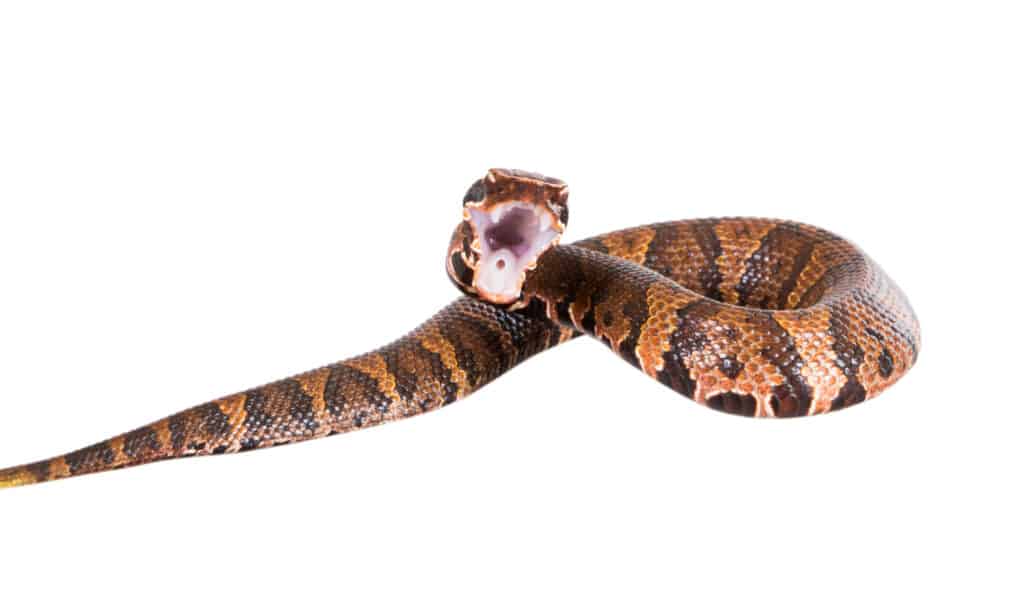
The copperhead is highly venomous and bite up to 3,000 people a year.
©IrinaK/Shutterstock.com
Non-Venomous Snakes that Look Like Copperheads in South Carolina
Copperheads are only one of six venomous species of snakes in South Carolina and one of nearly forty snakes in the state overall. As a result, it’s no surprise that many non-venomous species may look similar to the copperhead. This occurs for a variety of reasons, either through mimicking for protection or because of a shared habit.
While you should never handle a wild snake, venomous or not, it’s important to be able to know which is which. That way, in the case of an accidental bite, you can receive the exact help you need. Knowing which brown snakes are venomous and which aren’t can also help dispel the fear surrounding these important predators.
Corn Snake
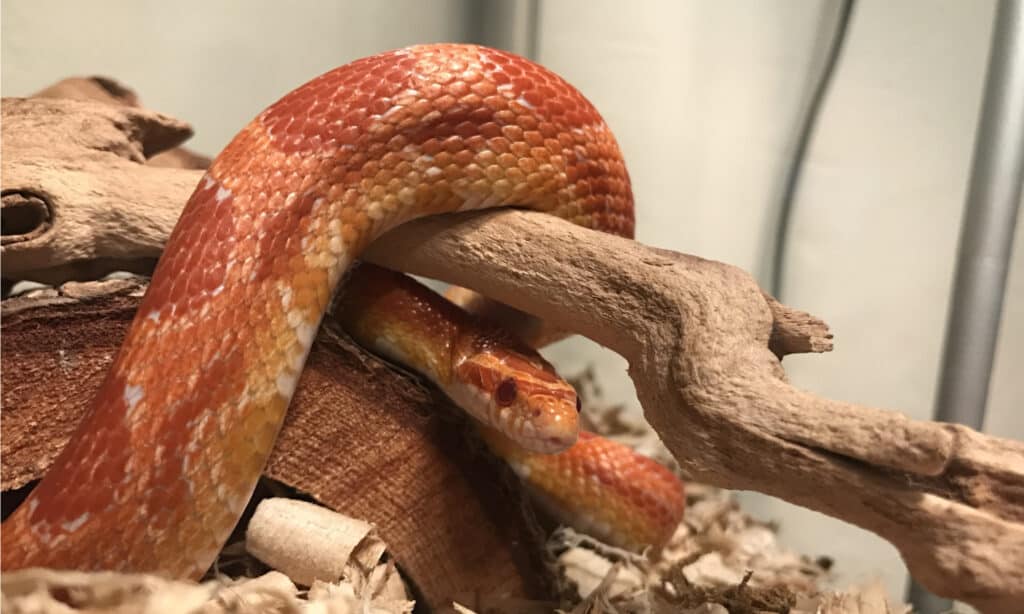
Corn snakes have a bright reddish color.
©Photohobbiest/Shutterstock.com
Despite being a popular pet, corn snakes are one of the snakes most commonly mistaken for a copperhead in South Carolina. While they lack a wide, flat head or an hourglass pattern, their bright reddish color can be confused for a copperhead’s copper coating from a distance. This is especially true since corn snakes have light bandings across their body.
Eastern Milk Snake
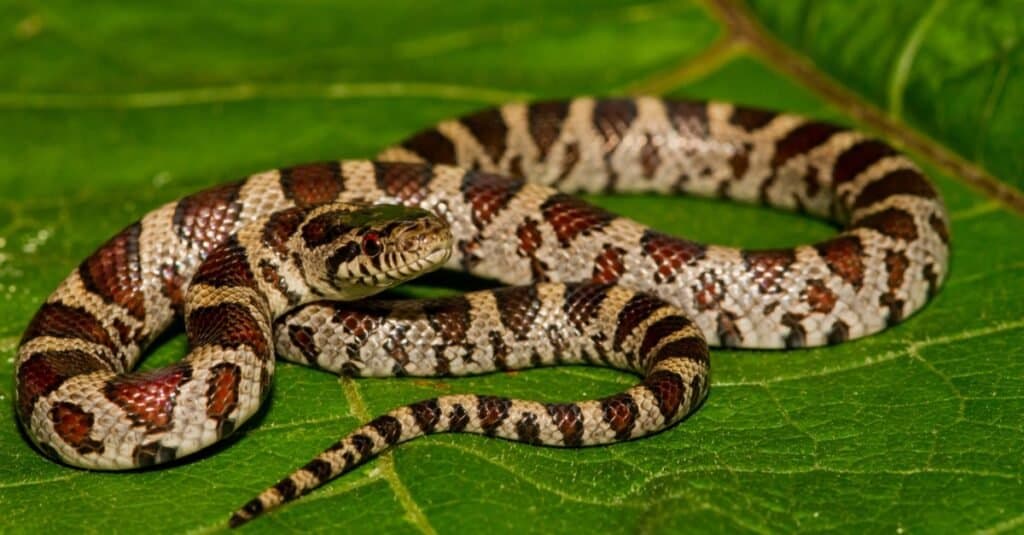
Eastern milk snakes hunt down small rodents often found on farm buildings and barns.
©Jay Ondreicka/Shutterstock.com
The eastern milk snake has a very similar pattern and coloration as the copperhead. Found most often in the mountain ranges of the state, it also happens to live in a similar habitat. However, the eastern milk snake is non-venomous. You can tell it apart because it lacks a uniform hourglass pattern, although it does have a pattern of its own, and its coloration is brighter, with more red hues than brown.
Mole Kingsnake

Mole kingsnakes have a similar color to copperheads.
©Krumpelman Photography/Shutterstock.com
The mole kingsnake is a non-venomous constrictor in South Carolina that likes to spend its time sun-bathing and hunting small rodents. While it maintains a color similar to copperheads their entire life, it typically uses any banding or patterns as it matures. However, some may keep this pattern, and even if they don’t, they can easily resemble the copperhead from afar.
Compared to copperheads, mole kingsnakes are much smaller and thinner, and they have small, angled heads.
Banded Water Snakes
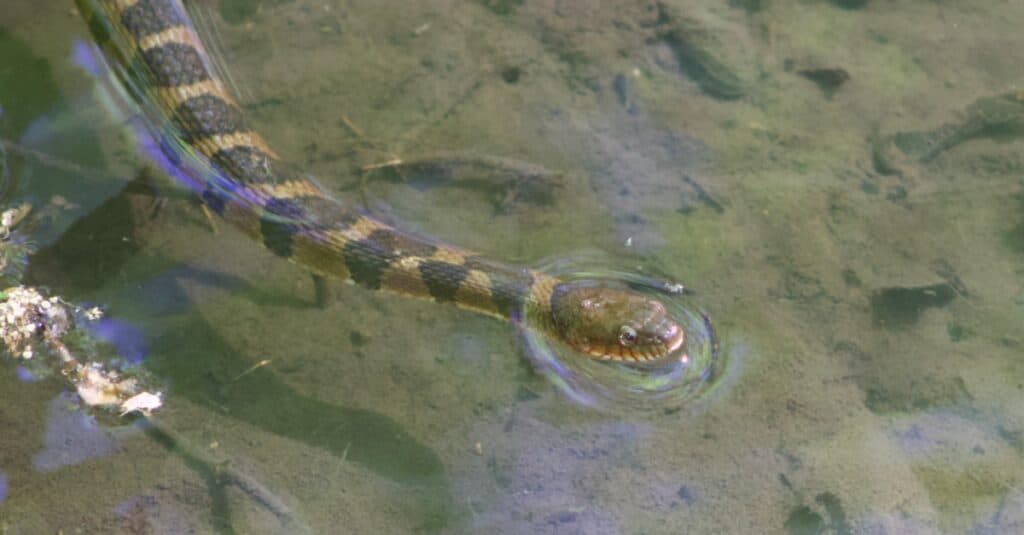
Banded water snakes reach a max of five feet in length.
©iStock.com/Dalene Capps
Because they’re found near bodies of water, banded water snakes may cross paths with a copperhead living in the swamps of South Carolina. These non-venomous reptiles also sport a similar reddish-brown coloration and banding, although they lack the hourglass pattern.
It can be difficult to tell the banded water snake apart from the copperhead. They can even mimic other venomous snakes in South Carolina. One of the best things to look for is their head shape, which will be smaller than the copperhead’s. If you aren’t sure, it’s best to pay extra care and avoid the snake altogether. However, you should avoid all wild snakes venomous or not.
The photo featured at the top of this post is © Scott Delony/Shutterstock.com
Discover the "Monster" Snake 5X Bigger than an Anaconda
Every day A-Z Animals sends out some of the most incredible facts in the world from our free newsletter. Want to discover the 10 most beautiful snakes in the world, a "snake island" where you're never more than 3 feet from danger, or a "monster" snake 5X larger than an anaconda? Then sign up right now and you'll start receiving our daily newsletter absolutely free.
Thank you for reading! Have some feedback for us? Contact the AZ Animals editorial team.






